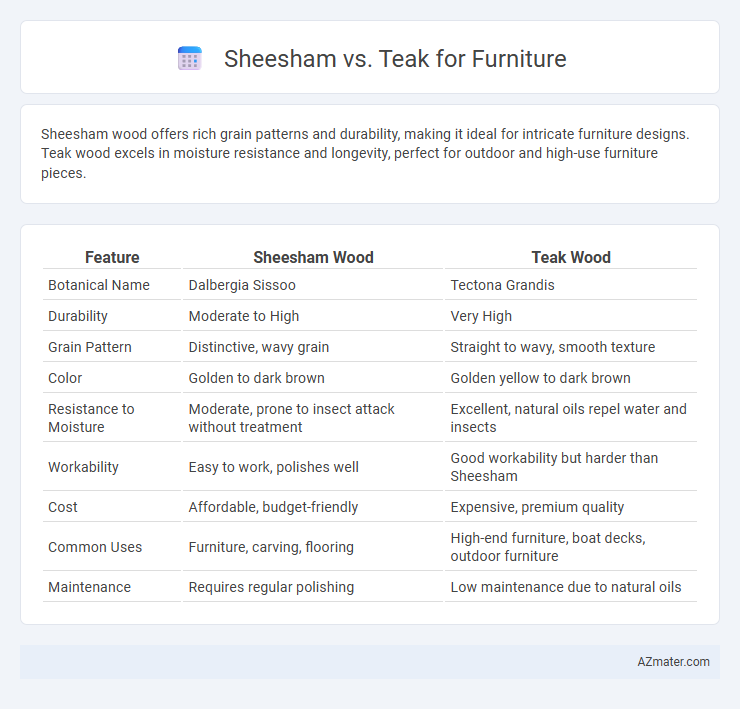Sheesham wood offers rich grain patterns and durability, making it ideal for intricate furniture designs. Teak wood excels in moisture resistance and longevity, perfect for outdoor and high-use furniture pieces.
Table of Comparison
| Feature | Sheesham Wood | Teak Wood |
|---|---|---|
| Botanical Name | Dalbergia Sissoo | Tectona Grandis |
| Durability | Moderate to High | Very High |
| Grain Pattern | Distinctive, wavy grain | Straight to wavy, smooth texture |
| Color | Golden to dark brown | Golden yellow to dark brown |
| Resistance to Moisture | Moderate, prone to insect attack without treatment | Excellent, natural oils repel water and insects |
| Workability | Easy to work, polishes well | Good workability but harder than Sheesham |
| Cost | Affordable, budget-friendly | Expensive, premium quality |
| Common Uses | Furniture, carving, flooring | High-end furniture, boat decks, outdoor furniture |
| Maintenance | Requires regular polishing | Low maintenance due to natural oils |
Introduction to Sheesham and Teak Wood
Sheesham wood, also known as Indian Rosewood, is prized for its rich grain patterns, durability, and natural resistance to pests, making it a popular choice for fine furniture. Teak wood, originating from Southeast Asia, is renowned for its exceptional strength, water resistance, and natural oils that protect it against decay, ideal for both indoor and outdoor furniture. Both Sheesham and Teak offer unique aesthetic and functional qualities, influencing their selection in various furniture applications based on durability and visual appeal.
Origin and Availability
Sheesham, also known as Indian Rosewood, originates primarily from the Indian subcontinent, including regions of Pakistan and Nepal, making it widely available in South Asian markets. Teak is native to Southeast Asia, especially Myanmar, Thailand, and Indonesia, and its natural availability is more limited due to extensive plantations and controlled logging. Both woods are sought after for durable furniture, but Sheesham's widespread growth in South Asia results in greater accessibility and cost-effectiveness compared to the more premium-priced teak.
Appearance and Grain Patterns
Sheesham wood features rich, dark brown hues with distinctive golden streaks, offering a warm and rustic appearance perfect for classic or traditional furniture designs. Teak wood showcases a more uniform golden to medium brown color with a smooth, straight grain pattern that gives furniture a sleek and refined look. The bold and varied grain of Sheesham adds character and texture, whereas Teak's consistent grain creates an elegant and polished finish.
Durability and Lifespan
Sheesham wood is renowned for its durability, offering resistance to decay and insect attacks, making it ideal for long-lasting furniture. Teak wood surpasses most hardwoods in durability due to its natural oils, which provide exceptional water resistance and protect against rot and termites. While Sheesham furniture typically lasts 10-15 years with proper care, teak furniture can endure 20-25 years or more, maintaining strength and aesthetic appeal over time.
Resistance to Termites and Decay
Sheesham wood exhibits strong natural resistance to termites and decay due to its dense grain and high oil content, making it a durable choice for furniture. Teak wood offers superior resistance to moisture, termites, and fungal attacks because of its natural oils and silica content, often outperforming Sheesham in longevity. Both woods provide excellent durability, but Teak's enhanced protection against decay and pests makes it particularly suitable for outdoor and high-moisture environments.
Maintenance and Care Requirements
Sheesham wood requires regular polishing and cleaning to maintain its rich grain and prevent drying or cracking, making it ideal for indoor furniture with moderate maintenance. Teak furniture demands less frequent care due to its natural oils that resist moisture, insects, and decay, often only needing occasional cleaning and oiling to preserve its golden-brown hue and durability. Both woods benefit from avoiding prolonged exposure to direct sunlight and moisture to enhance longevity and aesthetic appeal.
Price Comparison
Sheesham wood is generally more affordable than teak, making it a popular choice for budget-conscious furniture buyers without compromising durability. Teak commands a higher price due to its superior resistance to weather, insects, and decay, often used for premium outdoor and indoor furniture. The price difference can range from 20% to 50%, influenced by quality, sourcing, and market demand.
Environmental Impact and Sustainability
Sheesham wood, sourced primarily from India, is considered more sustainable due to faster growth rates and its status as a lesser-threatened species compared to teak, which is often harvested from slower-growing tropical forests. Teak offers high durability and resistance to pests, reducing the need for chemical treatments, but its extensive logging contributes to deforestation and habitat loss. Choosing Sheesham for furniture supports environmental sustainability through responsible harvesting and lower ecological impact while still providing sturdy, long-lasting products.
Best Uses for Each Wood Type
Sheesham wood excels in crafting sturdy furniture pieces like cabinets, dining tables, and antique-style chairs due to its rich grain and durability. Teak wood is best suited for outdoor furniture and high-end indoor pieces, offering exceptional resistance to weather, moisture, and pests. Both woods deliver long-lasting quality, but Sheesham's dense texture suits detailed carvings, while Teak's natural oils ensure superior longevity in harsher environments.
Final Verdict: Sheesham or Teak for Furniture?
Sheesham wood offers a rich grain and natural resistance to decay, making it ideal for decorative indoor furniture with moderate durability. Teak wood, renowned for its exceptional durability, water resistance, and strength, is superior for outdoor furniture and high-traffic indoor pieces requiring long-lasting performance. Selecting between Sheesham and Teak ultimately depends on the intended use and environmental exposure, with Teak preferred for longevity and Sheesham chosen for aesthetic appeal and budget-friendly furniture.

Infographic: Sheesham vs Teak for Furniture
 azmater.com
azmater.com